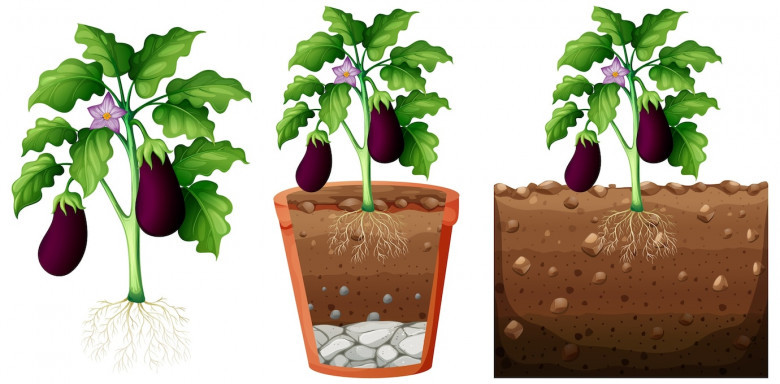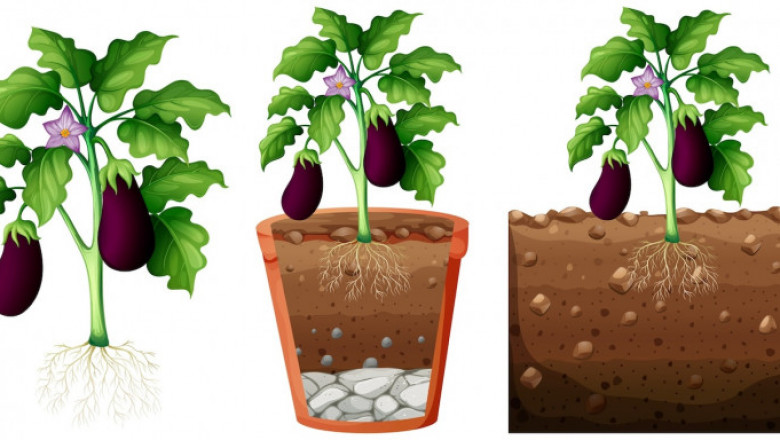views
In many places, eggplant, or brinjal, is a popular vegetable. It is famous for both its particular flavour and adaptability in the kitchen. Brinjals may be enjoyable to grow, but they need certain circumstances and attention.
We'll look at the key elements of brinjal growing in this blog. We shall talk about soil needs and climate first. Next, we will discuss planting methods, types, and land preparation. Additionally, focus on irrigation, weed control, and insect management. Finally, we will go over the harvesting procedure. A healthy and successful brinjal harvest can be done by following these recommendations.
Climate Conditions
Warm temperatures are ideal for growing brinjal. A temperature of between 25°C and 35°C is good. For it to grow, full sunlight is necessary. Avoid extremely low temperatures, as frost might harm crops. Plants grow more slowly at temperatures below 18°C. However, heat levels exceeding 40°C are harmful to flowers. Thus, it's essential to plant brinjal in a field that drains properly and receives plenty of sunlight. Furthermore, favourable weather conditions contribute to a rich and healthy crop.
Soil Requirements
Rich, well-drained soil is excellent for the growth of brinjal. For healthy root growth, loamy soil is perfect. A healthy growth requires a good amount of organic matter in the soil. Also, the optimal pH range for soil is 5.5 to 6.5. Soils with a lot of clay should be avoided since they might lead to waterlogging. Organic compost increases soil fertility and structure. Level and plough the ground before planting to prepare the soil. Healthy plants produce more when the soil is in good condition.
Varieties of Brinjal
There are several types of brinjal that are appropriate for various geographical areas. The popular varieties are Arka Nidhi and Pusa Purple Long. Farmers also appreciate Pant Rituraj for its high yield. Moreover, there are hybrid and traditional varieties available, so you can choose from them. Hybrids frequently provide better resilience to illnesses and pests. Conversely, conventional varieties grow in the region.
Choose your varieties always according to the conditions and market needs. Proper selection enhances both yield and quality.
Land Preparation
The first step in preparing the ground for brinjal is deep soil preparation. This enhances the texture of the soil and breaks up big clumps. For this process, farmers can use 5 feet Sonalika rotavator because with this implement, the soil becomes loose effortlessly. Moreover, the Sonalika rotavator 5-feet price is affordable, so you can get this in your budget.
To guarantee proper drainage, level the land after ploughing. Composted organic matter increases soil fertility. Additionally, you have to get rid of any weeds to avoid competing for nutrients.
Next, build channels or raised beds to improve water management. To prevent waterlogging, make sure the soil has enough drainage. In order to facilitate early development, add a base fertiliser lastly before planting. Strong and robust growth of brinjal plants is made easier by proper site preparation.
Sowing Techniques
Direct sowing or nursery rearing are two methods for seeding brinjal. Most farmers choose to start with a nursery. First, put seedlings in well-prepared nursery beds. Transfer the healthy seedlings onto the main field after four to five weeks. Moreover, to guarantee healthy development, the correct spacing between plants must be maintained. It is ideal to transplant during the colder parts of the day.
Although less frequent, direct seeding is still utilised in some areas. Better plant development and larger yields are the result of using proper planting strategies.
Irrigation
For good development, brinjal needs to be regularly irrigated. To help the roots settle, water the plants as soon as they are transplanted. Always keep the soil damp, but don't let it become too wet. During flowering and fruiting seasons, you should water your plants more often. Water conservation and reliable moisture are two great benefits of drip irrigation.
To keep the soil from drying out during hot weather, water more often. In order to enhance fruit quality, decrease watering before harvesting. Better growth and larger harvests of brinjal are guaranteed by effective water management.
Weed Control And Mulching
Controlling weeds is crucial for the good growth of brinjal. Eliminate weeds on a regular basis to avoid competing for nutrients. Herbicides or hand weeding are both options but always follow safety precautions. By covering the soil with organic materials like straw or plastic, mulching helps in the control of weeds.
Mulching also maintains a consistent soil temperature and moisture content. After transplanting, cover the area with mulch to prevent weed development and save water. You may develop stronger, healthier brinjal plants by mulching them well and controlling weeds.
Pest Control
Effective brinjal cultivation relies on proper insect management. Common pests include aphids, whiteflies, and fruit borers. Regularly inspect your plants for early signs of infestation. Using a cultivator helps maintain healthy soil and reduces pest habitats. For insect control, apply natural remedies like neem oil. Additionally, introducing beneficial insects can naturally reduce pest populations.
Use chemical insecticides in extreme situations, but make sure you consistently stick to the recommendations. Crop rotation can reduce the frequency of insect issues. Your Brinjal farm will provide more harvests and healthier plants if you practise proper pest management.
Harvesting
Time management is important while harvesting brinjal. When the fruits are solid and glossy, you should pluck them. Don't wait too long since overripe fruit becomes less delicious. To cut fruit without harming the plant, always use sharp instruments. To maintain freshness, harvest in the evening hours.
Brinjal matures quickly, so frequent plant checks are essential. Harvesting typically begins 70–90 days after transplanting. Using a harvester can make the process more efficient, ensuring higher-quality fruit. Proper harvesting techniques lead to better market prices and improved yield quality.
Conclusion
In conclusion, using the proper techniques may make brinjal cultivation beneficial. Begin by establishing the optimal climatic and soil conditions. Next, concentrate on using the right planting and watering methods.
To safeguard your crops, keep weeds and pests under regular management. Additionally, use efficient harvesting techniques to guarantee high-quality fruits. Applying these tips can help you harvest brinjal successfully. Recall that robust plants produce more at higher market pricing. Your brinjal farming may flourish with the right care and attention.























Comments
0 comment